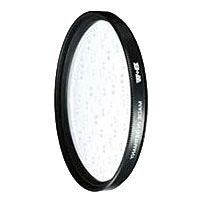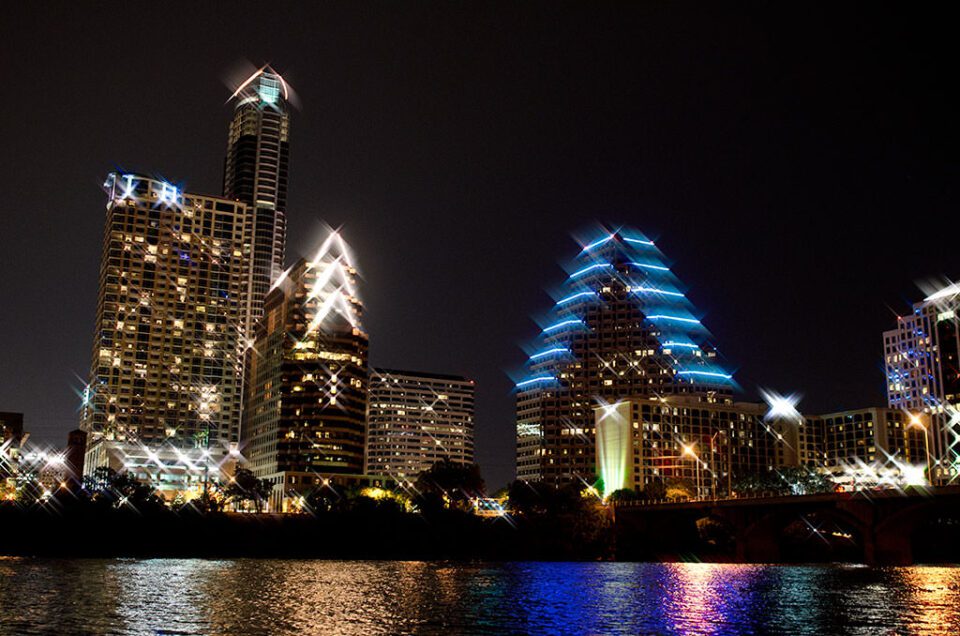10. مرشح المؤثرات الخاصة
يمكن أن تنتج مرشحات المؤثرات الخاصة بعض التأثيرات الرائعة، ولكن نظرًا لأنه يمكن إنتاج معظم التأثيرات بسهولة في Photoshop، فقد فقدت هذه المرشحات شعبيتها إلى حد كبير. نادرًا ما يحمل المصورون الرقميون هذه المرشحات وأنا شخصيًا لا أستخدمها أيضًا. يمكن إنشاء مرشح النجوم بسهولة في Photoshop من خلال بضع خطوات باستخدام مرشح "Motion Blur"، ويمكن أيضًا إجراء التوهج المخفف بسهولة من خلال بضع خطوات باستخدام مرشح "Gaussian Blur" ويمكن أيضًا عمل معظم المرشحات الأخرى في محل تصوير. المرشح الوحيد الذي لا يمكن إعادة إنتاجه في Photoshop هو مرشح bokeh لأنه لا يمكن تغيير الإبرازات بسهولة من خلال تقنيات ما بعد المعالجة.
إليك "تأثير النجمة" الذي مدته دقيقتان والذي قمت بإنشائه في Photoshop باستخدام تقنية بسيطة جدًا باستخدام مرشح Motion Blur:

تعد مرشحات المؤثرات الخاصة أكثر شيوعًا في الفيديو حيث يكون إنشاء التأثيرات أصعب أو يستهلك موارد الكمبيوتر أكثر. ومن الأمثلة على ذلك مرشح Moment CineFlare Blue Streak Filter الخاص بـ Moment، والذي يحاكي إلى حد ما التوهج الناتج عن العديد من العدسات المشوهة.
10. Special Effects Filter
 Special effects filters can produce some cool effects, but since most effects can be easily produced in Photoshop, these filters pretty much lost their popularity. Digital photographers rarely carry these filters and I personally do not use them either. The star filter can be easily created in Photoshop through a couple of steps using the “Motion Blur” filter, softening glow can also be easily done through a couple of steps with the “Gaussian Blur” filter and most other filters can also be done in Photoshop. The only filter that cannot be reproduced in Photoshop is a bokeh filter because the highlights cannot be easily changed through post-processing techniques.
Special effects filters can produce some cool effects, but since most effects can be easily produced in Photoshop, these filters pretty much lost their popularity. Digital photographers rarely carry these filters and I personally do not use them either. The star filter can be easily created in Photoshop through a couple of steps using the “Motion Blur” filter, softening glow can also be easily done through a couple of steps with the “Gaussian Blur” filter and most other filters can also be done in Photoshop. The only filter that cannot be reproduced in Photoshop is a bokeh filter because the highlights cannot be easily changed through post-processing techniques.
Here is a 2 minute “star effect” that I created in Photoshop using very simple technique with the Motion Blur filter:

Special effects filters are more popular in video where creating effects is either harder or more consuming of computer resources. An example is Moment’s Moment CineFlare Blue Streak Filter which simulates to some extent the flare caused by many anamorphic lenses.
يمكن أن تنتج مرشحات المؤثرات الخاصة بعض التأثيرات الرائعة، ولكن نظرًا لأنه يمكن إنتاج معظم التأثيرات بسهولة في Photoshop، فقد فقدت هذه المرشحات شعبيتها إلى حد كبير. نادرًا ما يحمل المصورون الرقميون هذه المرشحات وأنا شخصيًا لا أستخدمها أيضًا. يمكن إنشاء مرشح النجوم بسهولة في Photoshop من خلال بضع خطوات باستخدام مرشح "Motion Blur"، ويمكن أيضًا إجراء التوهج المخفف بسهولة من خلال بضع خطوات باستخدام مرشح "Gaussian Blur" ويمكن أيضًا عمل معظم المرشحات الأخرى في محل تصوير. المرشح الوحيد الذي لا يمكن إعادة إنتاجه في Photoshop هو مرشح bokeh لأنه لا يمكن تغيير الإبرازات بسهولة من خلال تقنيات ما بعد المعالجة.
إليك "تأثير النجمة" الذي مدته دقيقتان والذي قمت بإنشائه في Photoshop باستخدام تقنية بسيطة جدًا باستخدام مرشح Motion Blur:

تعد مرشحات المؤثرات الخاصة أكثر شيوعًا في الفيديو حيث يكون إنشاء التأثيرات أصعب أو يستهلك موارد الكمبيوتر أكثر. ومن الأمثلة على ذلك مرشح Moment CineFlare Blue Streak Filter الخاص بـ Moment، والذي يحاكي إلى حد ما التوهج الناتج عن العديد من العدسات المشوهة.
10. Special Effects Filter
 Special effects filters can produce some cool effects, but since most effects can be easily produced in Photoshop, these filters pretty much lost their popularity. Digital photographers rarely carry these filters and I personally do not use them either. The star filter can be easily created in Photoshop through a couple of steps using the “Motion Blur” filter, softening glow can also be easily done through a couple of steps with the “Gaussian Blur” filter and most other filters can also be done in Photoshop. The only filter that cannot be reproduced in Photoshop is a bokeh filter because the highlights cannot be easily changed through post-processing techniques.
Special effects filters can produce some cool effects, but since most effects can be easily produced in Photoshop, these filters pretty much lost their popularity. Digital photographers rarely carry these filters and I personally do not use them either. The star filter can be easily created in Photoshop through a couple of steps using the “Motion Blur” filter, softening glow can also be easily done through a couple of steps with the “Gaussian Blur” filter and most other filters can also be done in Photoshop. The only filter that cannot be reproduced in Photoshop is a bokeh filter because the highlights cannot be easily changed through post-processing techniques.Here is a 2 minute “star effect” that I created in Photoshop using very simple technique with the Motion Blur filter:

Special effects filters are more popular in video where creating effects is either harder or more consuming of computer resources. An example is Moment’s Moment CineFlare Blue Streak Filter which simulates to some extent the flare caused by many anamorphic lenses.

تعليق